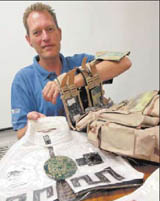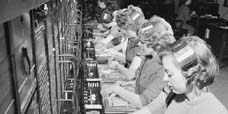March 24, 2005: Headlines: COS - Malawi: Medicine: Drugs: Research: Biometrics: Engineering: Nanotechnolgy: East Valley Tribune: Malawi RPCV Frederic Zenhausern is developing two prototypes of "biometric bodysuits" that contain embedded sensors, power sources, microfluidic devices and other gadgets not normally associated with the latest Paris fashions
Peace Corps Online:
Peace Corps News:
Library:
January 23, 2005: Index: PCOL Exclusive: Engineering and Energy :
Archive of Stories:
March 24, 2005: Headlines: COS - Malawi: Medicine: Drugs: Research: Biometrics: Engineering: Nanotechnolgy: East Valley Tribune: Malawi RPCV Frederic Zenhausern is developing two prototypes of "biometric bodysuits" that contain embedded sensors, power sources, microfluidic devices and other gadgets not normally associated with the latest Paris fashions
Malawi RPCV Frederic Zenhausern is developing two prototypes of "biometric bodysuits" that contain embedded sensors, power sources, microfluidic devices and other gadgets not normally associated with the latest Paris fashions

Malawi RPCV Frederic Zenhausern is developing two prototypes of "biometric bodysuits" that contain embedded sensors, power sources, microfluidic devices and other gadgets not normally associated with the latest Paris fashions
Researchers build what they envision as wearable computers
Caption: Frederic Zenhausern, a research professor and director for the center for Applied NanoBioscience at Arizona State University, has helped develop clothing that has microelectronics incorporated into its design. Photo: Jennifer Grimes Tribune
By Ed Taylor, Tribune
Computer chips, sensors and other mini electronic devices have become embedded in just about everything — cars, toasters, credit cards, even dogs and cats.
The next frontier for microelectronics may be clothing, according to an Arizona State University researcher who is trying to merge technology with fashion.
Frederic Zenhausern, director of the Applied NanoBioscience Center at ASU, has joined with Ghassan Jabbour, a professor at the University of Arizona, to develop two prototypes of "biometric bodysuits" that contain embedded sensors, power sources, microfluidic devices and other gadgets not normally associated with the latest Paris fashions.
Such "smart" clothing could give future soldiers early warning of chemical attacks or automatically deliver insulin to diabetics, Zenhausern said.
"The biometric bodysuit shows how electronics and fluidics can be incorporated into clothing to perform a wide range of tasks, from highly functional to the aesthetic," he said.
The two prototypes, dubbed Scentsory Chameleon Bodysuits, were displayed May 14-16 at NextFest 2004, a future-technologies show sponsored by Wired magazine and General Electric in San Francisco.
One of the prototypes is a military outfit that includes sensors that could "sniff" the air for chemical or biological agents, lowtemperature fuel cells that would provide a lightweight power source for a soldier’s equipment and a flexible electroluminescent display that wraps onto the cuff to give the soldier updated commands, warnings and other information.
Jabbour is an expert on flexible displays, which are composed of molecules that emit light under certain conditions. By placing the molecules on a flexible substrate such as plastic, the result is a computer-like display screen that can move and bend.
Also exhibited at Next-Fest was a biometric outfit that demonstrates how miniature electronics could be embedded in clothing to promote health. It is made of clear vinyl and white plastics to show the placement of various electronic and fluidic devices. In the future, such an outfit could diagnose diseases and deliver medications to the wearer, monitor heart rate or blood pressure, deliver interactive games and other forms of entertainment or function as a wearable computer.
Another possibility would be to download different designs from the Internet so the fabric could change colors and patterns, Zenhausern said. And it could all be made to look stylish by blending the electronics with high-fashion designs, he said.
The personal wellness garment was developed by Zenhausern with Galina Mihaleva, a costume designer in the dance department at the ASU Herberger College of Fine Arts; and Jenny Tillotson, a clothing designer based in London.
Dr. James Canton, chief executive of the Institute for Global Futures in San Francisco, said biometric clothing could reach the market in a few years. He said Levi Strauss & Co. already produces clothes with a nanotech coating that resists stains.
Biometric clothes are likely to be adopted first by the military, but personal security concerns could move it quickly to the civilian market, he said.
"We will wear our own biometric bar code that can usher us more quickly through airports," he said. "If terrorists bomb a few more shopping malls, we will be willing to trade privacy for better security."
The concept of embedding microelectronics in fabrics has potential far beyond clothing. Sheila Kennedy, a Boston-based architect and visiting professor at the Harvard University Graduate School of Design, sees possibilities for the technology in building design. As an example, she said window shades containing organic light emitting diodes could produce electricity from sunlight that would help generate power.
"I foresee the day when a substantial portion of a building’s energy is generated from the exterior envelope," she said.
Contact Ed Taylor by email, or phone (480) 898-6537
When this story was posted in March 2005, this was on the front page of PCOL:
Peace Corps Online The Independent News Forum serving Returned Peace Corps Volunteers
 | The Peace Corps Library
Peace Corps Online is proud to announce that the Peace Corps Library is now available online. With over 30,000 index entries in over 500 categories, this is the largest collection of Peace Corps related reference material in the world. From Acting to Zucchini, you can use the Main Index to find hundreds of stories about RPCVs who have your same interests, who served in your Country of Service, or who serve in your state. |
 | Crisis Corps arrives in Thailand
After the Tsunami in Southeast Asia last December, Peace Corps issued an appeal for Crisis Corps Volunteers and over 200 RPCVs responded. The first team of 8 Crisis Corps volunteers departed for Thailand on March 18 to join RPCVs who are already supporting relief efforts in Sri Lanka, Indonesia, Thailand, Malaysia, and India with other agencies and NGO's. 19 Mar 2005 |
 | RPCVs in Congress ask colleagues to support PC
RPCVs Sam Farr, Chris Shays, Thomas Petri, James Walsh, and Mike Honda have asked their colleagues in Congress to add their names to a letter they have written to the House Foreign Operations Subcommittee, asking for full funding of $345 M for the Peace Corps in 2006. As a follow-on to Peace Corps week, please read the letter and call your Representative in Congress and ask him or her to add their name to the letter. |
 | Add your info now to the RPCV Directory
Call Harris Publishing at 800-414-4608 right away to add your name or make changes to your listing in the newest edition of the NPCA's Directory of Peace Corps Volunteers and Former Staff. Then read our story on how you can get access to the book after it is published. The deadline for inclusion is May 16 so call now. |
 | March 1: National Day of Action
Tuesday, March 1, is the NPCA's National Day of Action. Please call your Senators and ask them to support the President's proposed $27 Million budget increase for the Peace Corps for FY2006 and ask them to oppose the elimination of Perkins loans that benefit Peace Corps volunteers from low-income backgrounds. Follow this link for step-by-step information on how to make your calls. Then take our poll and leave feedback on how the calls went. |
 | Make a call for the Peace Corps
PCOL is a strong supporter of the NPCA's National Day of Action and encourages every RPCV to spend ten minutes on Tuesday, March 1 making a call to your Representatives and ask them to support President Bush's budget proposal of $345 Million to expand the Peace Corps. Take our Poll: Click here to take our poll. We'll send out a reminder and have more details early next week. |
Read the stories and leave your comments.

Some postings on Peace Corps Online are provided to the individual members of this group without permission of the copyright owner for the non-profit purposes of criticism, comment, education, scholarship, and research under the "Fair Use" provisions of U.S. Government copyright laws and they may not be distributed further without permission of the copyright owner. Peace Corps Online does not vouch for the accuracy of the content of the postings, which is the sole responsibility of the copyright holder.
Story Source: East Valley Tribune
This story has been posted in the following forums: : Headlines; COS - Malawi; Medicine; Drugs; Research; Biometrics; Engineering; Nanotechnolgy
PCOL17906
37
.















